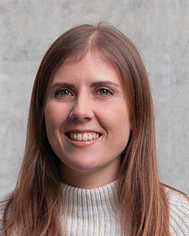Materials Horizons Emerging Investigator Series: Dr Jess M. Clough, Adolphe Merkle Institute, University of Fribourg, Switzerland
Jess M. Clough is an assistant professor at the Adolphe Merkle Institute in Fribourg, Switzerland, where she leads the Mechanoresponsive Materials research group. She completed her undergraduate studies in natural sciences at the University of Cambridge, and obtained her PhD on mechanoluminescence in polymers, supervised by Professor Rint Sijbesma at Eindhoven University of Technology. As a postdoctoral researcher with Professor Joris Sprakel at Wageningen University, she investigated colloidal photonic materials for use as pigments. She moved to Switzerland to pursue a Women in Science postdoctoral fellowship from the NCCR Bio-Inspired Materials within the group of Professor Christoph Weder. In 2022, she was awarded a PRIMA grant from the Swiss National Science Foundation to start her own independent group at the University of Fribourg. Her group's current research is focused on developing optical reporters of mechanical deformation for polymeric materials.
Read Jess M. Clough's Emerging Investigator Series article ‘Microscopic strain mapping in polymers equipped with non-covalent mechanochromic motifs’ ( https://doi.org/10.1039/D3MH00650F ) and read more about her in the interview below:
MH: Your recent Materials Horizons Communication on ‘Microscopic strain mapping in polymers equipped with non-covalent mechanochromic motifs’ presents a new methodology for detecting, quantifying, and mapping defects in polymeric materials using mechanochromic polyurethane films. How has the direction of your research evolved from your first article to this most recent article and where do you see your own research going in future?
JC: After starting out in organic and supramolecular chemistry, I delved deeper into polymer materials science and imaging techniques during my career, which is reflected in my Materials Horizons communication. Nevertheless, chemistry remains at the core of my research. In fact, you could say that in some ways my most recent article takes me back to where I started, because the molecules at the heart of both my first and most recent articles are strikingly similar. As a Master's student, I worked on the supramolecular assembly of naphthalene diimides (NDI); in this article, we employed a molecular mechano-sensor, or mechanophore, that is based on supramolecular interactions between perylene diimides, NDI's bigger brother. Looking towards the future, we aim to apply these tools and techniques to elucidate damage mechanisms in polymeric materials, to understand how they fail and to design materials with improved mechanical characteristics.
MH: What aspect of your work are you most excited about at the moment?
JC: One aspect I’m particularly excited about is highlighted in my Materials Horizons article. Specifically, we demonstrated that we could image the local strain around defects in polymeric matrices with confocal microscopy. This work has served as an important stepping stone to current projects in my group, which focus on developing new tools and techniques for imaging the local properties of polymer matrices with high spatial resolution. In the past, limited resolution has obscured the true nature of force-induced processes in these materials, which are often nano- or microscopic in origin.
MH: In your opinion, what are the most important questions to be asked/answered in this field of research?
JC: Until now, mechanophores have been largely applied in academic studies to engineering polymers commonly found in load-bearing applications, such as polyurethanes, toughened glasses and fibre composites. It will be interesting to see in the future if they can be more widely applied in industrial contexts. Moreover, mechanical forces impact material performance in diverse contexts: for example, in the polymer components of wearable electronics, and in hydrogel replacements for cartilage in joints. Mechanical forces play a significant role in biological systems too, such as in plant cells, which must withstand turgor pressures of up to 20 atmospheres (much greater than the air pressure in a car tire). The effect of force on their growth and differentiation is not well understood. I think it would be fascinating to apply molecular mechano-sensors to these systems. These applications would require the development of molecular optical strain sensors that respond to smaller forces and can be incorporated in aqueous environments.
MH: What do you find most challenging about your research?
JC: Our research is highly interdisciplinary, encompassing organic synthesis, photochemistry, polymeric materials characterisation and mechanics, microscopy and imaging. This makes the work challenging but also stimulating.
MH: In which upcoming conferences or events may our readers meet you?
JC: I will be attending the ACS Fall conference in San Francisco in August, and also the Timişoara 2023 European Capital of Culture event in December to discuss my art–science collaborative project with photographer Claudia Christen (funded by the NanoARTS initiative of ProHelvetia).
MH: How do you spend your spare time?
JC: Hiking has become a big passion for me since I moved to Switzerland. I love the beauty of the mountains, and the sense of satisfaction after completing a long hike. Quite a bit of my spare time is dedicated to learning languages: I live in a German-speaking town (Bern) with an Italian partner and work in a French-speaking town (Fribourg).
MH: Can you share one piece of career-related advice or wisdom with other early career scientists?
JC: It's hard to give general advice, as everyone is so different. I recommend discussing your aspirations with advisors and mentors proactively and making a career plan. When I was younger, I was shy to admit that I wanted to stay in academia, partly from a fear of not being good enough. But communicating clearly what you want will enable others to help you achieve this.
| This journal is © The Royal Society of Chemistry 2023 |

